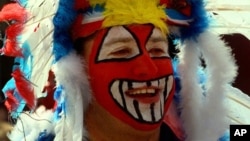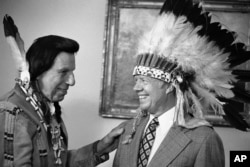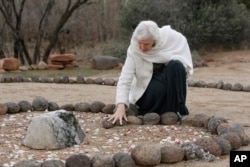Many cite a 1970s television ad for launching what is today a global movement to save the earth. It featured a Native American in buckskins and braids who shed a single tear over the destruction of America’s once-pristine landscape. Later, it was revealed that the actor, Iron Eyes Cody, was not Native American at all, but a second-generation Italian who fabricated a heritage that won him roles in Hollywood.
Since then, a number of public figures have been “outed” for fictitious claims to Indian ancestry.
The irony isn’t lost on legitimate tribal people, who for generations have suffered discrimination by a dominant society.
“There’s a strange paradigm of people wanting to pursue cultures that aren’t theirs,” said Ben Barnes, second Chief of the Shawnee Tribe in Oklahoma. “But they step over the line when they start claiming to be those ethnicities and speaking for people of those ethnicities.”
Some folks really believe their claims, said Barnes. Others are driven by spiritual void. Still others think minority status will open doors for jobs. And it’s not just individuals who are posing as Natives.
“The Cherokee tribe has identified over 400 groups claiming to be Cherokee clans, bands or tribes,” said David Cornsilk, a genealogist and citizen of the Cherokee Nation, one of three federally-recognized Cherokee tribes. “These folks are historical revisionists. They take little snippets of our history, expound on it and then insert themselves into it.”
During the 19th Century, the U.S. government forced thousands of Cherokee out of their traditional land in Georgia and Alabama, marching them along a “trail of tears” to Oklahoma. Phony Cherokees often claim that their ancestors dropped off the trail and stayed in hiding for generations.
Some unrecognized tribes manage to access federal funds intended for legitimate tribes.
A 2012 U.S. Government Accounting Office study found that between 2007 and 2010, 24 federal programs awarded more than $100 million to 26 non-federally recognized tribes.
Nearly $80 million went to the Lumbee of North Carolina, whose earlier petition for recognition was turned down by the Department of the Interior (DOI) because it was a “recently formed organization” with no relation to the historic tribe of the same name.
Scam artists
The U.S. government recognizes more than 500 tribes, mostly through historic treaties. Non-treaty tribes wanting recognition must meet strict requirements.
Occasionally, groups have tried to hoodwink federal authorities, said Nedra Darling, public affairs director for DOI’s Assistant Secretary for Indian Affairs.
“A Mr. Ron Roberts claimed to represent a group known as the ‘Western Mohegan Tribe and Nation of New York.’ Mr. Roberts forged several documents,” she told VOA in an email. Roberts, a former country singer and traveling evangelist, had hoped to open a casino, something allowed by law on recognized reservations.
In 1984, the DOI also turned down a petition by the so-called Kaweah Indian Nation, Inc., led by a non-Indian named Malcolm Webber, who sold phony memberships to illegal immigrants, promising immunity from deportation.
Both men were federally prosecuted.
Selling the sacred
Today, scores of phony shamans claim to heal the mind and body through Native American spiritual ceremonies like the sweat lodge, a type of sauna practiced by Native peoples for centuries. The results can be deadly.
In October 2009, three people died of heat and dehydration in a mock sweat lodge as part of a five-day, $10,000 spiritual retreat organized by a prominent self-help author.
Phony “Native American Churches” promote using peyote and other drugs. In August 2016, a North Carolina woman died after ingesting ayahuasca, a psychedelic Amazonian brew peddled as “life-changing.”
“These fake groups are often led by very charismatic individuals who want to surround themselves with sycophants who hang on their every word,” said Cornsilk, adding, “It’s almost like Jonestown,” a reference to the American religious cult in Guyana whose members committed mass suicide on the instruction of their leader.
Legitimate tribes and organizations have been vocal in their outrage. In 1993, a gathering of the Lakota, Dakota and Nakota Nations passed a unanimous “Declaration of War Against Exploiters of Lakota Spirituality.”
“For too long we have suffered the unspeakable indignity of having our most precious Lakota ceremonies and spiritual practices desecrated, mocked and abused by non-Indian wannabes, hucksters, cultists, and self-styled New Age shamans and their followers,” it read.
The National Council of Native American Churches, which represents legitimate religious organizations, issued a 2016 statement recalling that Native Americans were historically punished for practicing their religions.
“We know who we are, and we know where we come from,” it read. “We know the atrocities visited upon us. We reject the attempts to grasp onto our indigenous ways and deceive the public by claiming them as their own for their own personal enjoyment or for profit.”
Shawnee Ben Barnes put it this way: “Imagine I were to stand on a street corner and start delivering Holy Communion. People would freak out!"















